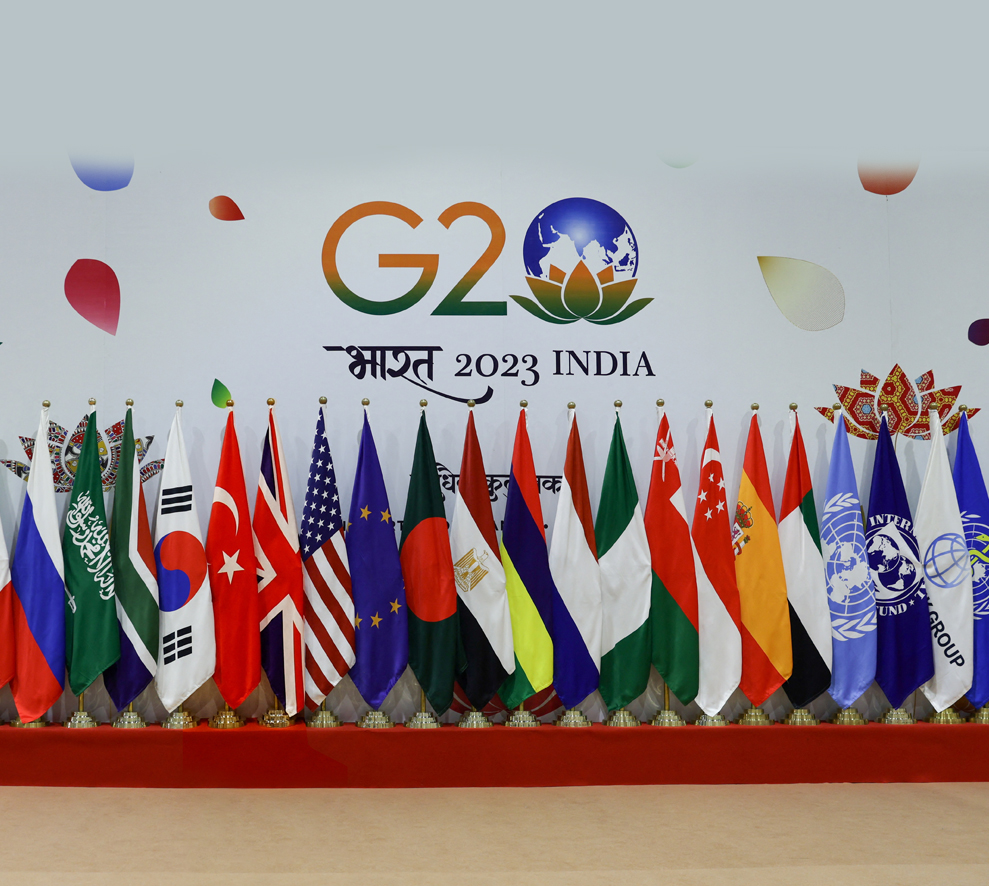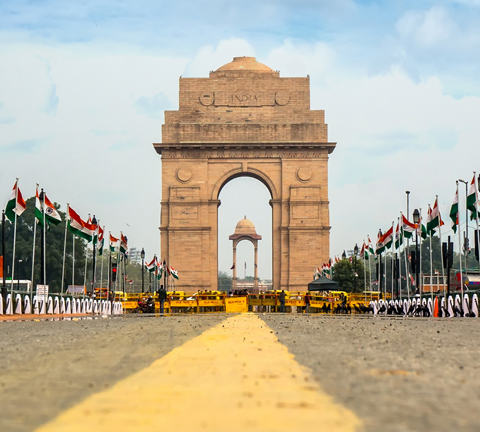On September 9 and 10, 2023, India hosted the G20 Summit, which revealed an unprecedented level of division and polarization in the international “summit process” since its inception in the early 1990s. The G20 Summit, which lacked the participation of the Russian and Chinese presidents, failed to reach a consensus on key global issues of contention among its members, such as the Ukrainian crisis, the transition away from fossil fuels, and debt restructuring. These issues were prominently reflected in the final summit communique.
The outcomes and implications of September’s summit are likely to signify a new phase in the evolution of the global order, especially in light of the launch of the India-Middle East-Europe corridor and the endorsement by the United States and the European Union of the Lobito Corridor that connects Zambia and the Democratic Republic of Congo to regional and global trade markets through the port of Lobito in Angola.
Moves and Circumstances before the Summit:
The Ukrainian crisis, which erupted in spring 2022, triggered a new phase of polarization in international conflicts between NATO countries, led by the United States of America, and Russia and China. This phase has been marked by several significant developments.
First, on March 10, 2023, Saudi-Iranian relations were restored with Chinese mediation. Both countries reaffirmed their commitment to respecting sovereignty and refraining from interfering in one another’s domestic affairs. Saudi Arabia and Iran also activated the security cooperation agreement they signed in 2001, as well as the cooperation agreement covering various domains, including economy, trade, investment, technology, science, culture, sports, and youth signed in 1998.
1.jpg)
Second, on May 7, 2023, a quadrilateral meeting of national security advisers from the United States, Saudi Arabia, the United Arab Emirates, and India was held in Riyadh, where the idea of a joint infrastructure project connecting the Gulf and Arab countries with India through a network of railways and seaports was proposed. This concept originated from the I2U2 Group founded by India, Israel, the United States, and the United Arab Emirates in 2021. On July 30, 2023, Israeli Prime Minister Benjamin Netanyahu announced that Israel was working on constructing a railway and suggested the potential of connecting it with Saudi Arabia in the future.
Third, Riyadh hosted the 10th Arab-Chinese Business Conference June 11–12, 2023, which unveiled a modern “Silk Road” between China and the Arab world as part of the plan to align Saudi Arabia’s Vision 2030 with China’s Belt and Road Initiative. This announcement carried significant implications, including Saudi Arabia’s pledge to serve as a bridge connecting the Arab world with China and linking the region within itself as well as its neighboring regions in Africa, Europe, and Asia.
Fourth, on August 18, 2023, a trilateral summit at Camp David took place between the presidents of the United States, Japan, and South Korea, who agreed to adopt a hotline, hold an annual summit, and significantly raise the level of trilateral defense cooperation, including conducting annual joint military exercises.
Fifth, on August 24, 2023, the BRICS group—Brazil, Russia, India, China, and South Africa—declared its intention to admit six new members: Argentina, Ethiopia, Iran, Saudi Arabia, Egypt, and the United Arab Emirates. All six countries expressed their approval of this decision.
The Geostrategic Competence Intensifies
All of the positions and events mentioned above intensified during the G20 Summit, primarily revolving around the issue of escalating polarization between the United States and its Western allies on one side and Russia and China on the other. This escalation led to heightened levels of geostrategic competition over various regions of the world. These dynamics were clearly reflected in the indicators observed during the two days of the summit.
First, the United States exhibited a strong interest in participating in the Summit, where it announced projects with its allies, such as the “India-Middle East-Europe” corridor, which posed a challenge to China’s Belt and Road Initiative. The United States also sought maximum support for its policies, positions, and projects from G20 members and aimed to strengthen its ties with India, which is seen as a key arena of potential confrontation with China.
.jpg)
Second, the Russian and Chinese presidents did not attend the summit. This absence conveyed significant messages and implied a shifting focus toward other groups that are expected to play a crucial role in the future, such as BRICS and the Shanghai Cooperation Organization.
Third, the summit fell short of satisfying American and European aspirations to achieve a consensus denouncing Russian military operations in Ukraine. Despite pressure, Ukrainian President Volodymyr Zelensky—in contrast to the 2022 G20 Summit in Bali, Indonesia—did not deliver a video speech at this year’s summit in New Delhi.
Fourth, India successfully elevated its emerging international status as a political and economic global “pole.” It inherited the legacy of the Non-Aligned Movement to advance interests of developing countries in the context of Cold War confrontation and maintained that stance after the Cold War. India also drew global attention to its long-term vision for combatting climate change and promoting investments in renewable energy, notably through its leadership of the International Solar Alliance.
Fifth, a notable outcome of the summit was the inclusion of the African Union as a G20 member. This development carries significant implications in the context of escalating international rivalry for influence in Africa. Interestingly, this move received endorsement from the three major powers (the United States, Russia, and China) despite their divergent positions on most other issues. It suggests their common interest in aligning the African Union with their global agenda through the G20 platform.
Post-G20 Summit
This year’s G20 Summit marks a significant turning point in the trajectory of its member countries and the future of conventional international blocs. This turning point held various indicators, including:
First, the diminishing role of the G20 in comparison to previous years
was evident in the absence of the Russian and Chinese presidents and in the summit’s consensual and reconciliatory Leaders’ Declaration, which revealed profound divergences on key issues among the group’s major players. This was particularly apparent in the context of the Ukrainian crisis, and it contrasts with the unequivocal condemnation of Russia that occurred at last year’s G20 Summit in Bali.
Second, the waning U.S. influence over the G20 participants, which was evident in India’s refusal to comply with Washington’s requests to allow Zelensky a chance to speak at the summit through video conferencing.
Third, the United States’ interest in the summit and its relationship with India stem from its strategic vision to bolster the ASEAN bloc of 10 Southeast Asian countries and establish India’s security role within the QUAD framework, in contrast to China’s strategy, which aims to undermine U.S.-allied relations in East Asia.
.jpg)
Fourth, China’s silence regarding the India-Middle East-Europe Economic Corridor reflects its awareness of America’s intentions to undermine China’s competitive edge. It also signifies China’s commitment to implementing its strategies through various channels without escalating to direct confrontation with the United States. In this context, Beijing seeks to enhance the efficiency and effectiveness of political and economic blocs that align more closely with its goals, such as BRICS and the Shanghai Cooperation Organization.
Fifth, despite their differences on various issues and policies, the relationship between Russia and China is evolving to counter U.S. influence. As both countries share aspirations for a multipolar world order, the United States now faces two formidable poles with distinct strategies, policies, and stances on specific issues. However, they concur on a grand strategy that prevents America from maintaining sole or dominant power in the next international order.
Sixth, the emergence of global ambitions among certain countries and regional groups, such as the African Union, and their efforts to bolster their international standing in a post-Ukrainian crisis world based on their national interests. These interests have become increasingly evident, prompting them to disengage from the subordination to traditional global power centers and toward a greater inclination to diversify their options, forge multiple alliances, and avoid conflicts.
In conclusion, the G20 Summit in India has deviated from its original purpose of addressing global issues and challenges. Instead, it has become a reflection of the disarray in the global system and the contestation among its major poles. The corridor spanning from India to Europe via the Middle East symbolizes the geopolitical competition and significant disparities in perspectives across all aspects of the global system, including political and economic relations, as well as various interactions and events.
Keep in touch
In-depth analyses delivered weekly.

Related Analyses:








